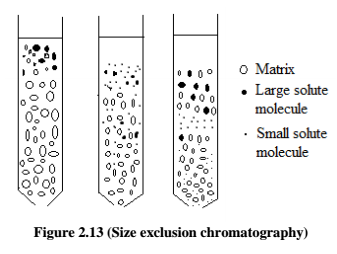Q.5. (b) Write an exhaustive note on size exclusion chromatographic technique and its pharmaceutical applications
[adsense:336x280:8701650588]
Ans.5. (b)Size exclusion chromatography:Size exclusion or gel chromatography is a power-full technique that is particularly applicable to high-molecular mass species. In this technique porous material as the stationary phase and a liquid as a mobile phase,the diameter of the pore of the porous material are of the order of 50 – 3000Ǻ, which is similar to the size of many molecules,the latter penetrate the pores according to their size. Small molecules penetrate more rapidly than larger molecules, which frequently are excluded from the smaller pores present. This results in a difference in the rates at which the molecules pass down the column, the smaller molecules travelling faster than the larger molecules. In this technique separation takes place according to size of the solute molecule. Exclusion takes place according to molecular size.
Principle The selection of molecules on the basis of their molecular size and shape utilizes the molecular sieve properties of a variety of porous materials. Probably the most commonly used of such materials are a group of polymeric organic compounds which possess a three dimensional network of pores which confer gel properties upon them. The general principle of exclusion chromatography is quite simple. A column of gel particles or porous glass granules is in equilibrium with a suitable solvent for the molecules to be separated. Large molecules which are completely excluded from the pores will pass through the interstitial spaces, while smaller molecules will be distributed between the solvent inside and outside the molecular sieve and will then pass through the column at a lower rate. Three stages in such a column are represented diagrammatically in the figure 2.13.

Theory The total volume Vtof a column packed with a porous polymer or silica gel is given by Vt = Vg + Vi + Vo
Where Vg is the volume of occupied by the solid matrix of the polymer or gel, Vi is the volume of solvent held in its pores, and Vo is the free volume outside the particles. Assuming no mixing or diffusion, Vo also represents the theoretical volume of solvent required to transport through the column those components too larger to enter the pores. In fact, however, some mixing and diffusion will occur, and as a result the un-retained components will appear in a Guassian-shape band with a concentration maximum at Vo.for components small enough to enter freely into the pores of the polymer or gel, band maxima will appear at the end of column at an eluent volume corresponding (Vi + Vo). Generally, Vi, Vo, and Vg are of the same order of magnitude; thus, a size-exclusion column permits separation of the large molecules of a sample from the small molecule with a minimal volume of elute.
Molecules of intermediate size are able to transfer to some fraction K of the solvent held in the pores; the elution volume Ve for these retained molecules is Ve = Vo + KVi
This equation applies to all of the solutes on the column. For molecules too large to enter the pores, K = 0 and Ve = Vo; for molecules that can enter the pores unhindered, K = 1 and Ve = (Vo + Vi). in deriving equation the assumption is made that no interaction, such as adsorption, occurs between the solute molecules and the polymer of gel surfaces. With adsorption, the amount of interstitially held solute will increase; with small molecules, K will then be greater than unity.
Equation can be rearrange such as : K = (Ve – Vo) / Vi = CS/CM
Where K is the distribution constant for the solute, Values of K range from zero to totally excluded large molecules to unity for small molecules.
Materials
Gels which are commonly usedinclude cross-linked dextran, agarose, polyacrylamide, polyacryloylmorphine and polystyrenes
Column packaging
There are generally two types of column packaging; porous glasses or silica and porous cross linked organic gels such as dextran, methylacrylate- base gels, polyvinyl alcohol-based gels, and hydroxethyl cellulose gels.
Detectors
The detectors used are based on UV fluorescence, UV absorption, or changes in refractive index.
PharmaceuticalApplications
Size-exclusion chromatography has been used with great success in the separation of the sugars, polypeptides, proteins, liquids, asphalts, butyl rubbers, polyethylene’s, polystyrenes, silicon polymers, and others. Size exclusion chromatography has been mainly applied to studies of complex, biochemical or highly polymerized molecules.
The main application of size-exclusion chromatography is the separation and characterization of molecules of different molecular weights. Very often it becomes possible to separate molecules of similar molecular weights by a proper selection of the appropriate gel and column length.
Another important application is the separation of large molecules of the biological origin from inorganic and ionizable species. This is termed as desalting.
Find more info on Next Page...
Subscribe to Pharmatutor Job Alerts by Email
For example: Employing a column of sephadex gel, haemoglobin can be separated from sodium chloride. The method can be also be used for preparative purpose. However, the main applications of the size exclusion chromatography are as follows:
a. Purification: The main application of exclusion chromatography is in the purification of biological macromolecules. Viruses, proteins, enzymes, hormones, antibodies, nucleic acids, and polysaccharides have all been separated and purified by the use of appropriate gels or glass granules.
b. Molecular weight determination: the effluent volumes of globular proteins are largely determined by their molecular weight. It has been shown, that over a considerable molecular weight range, the effluent volume is approximately a linear function of the logarithm of the molecular weight.
c. Solution concentration: solution of high molecular weight substances can be concentrated by the addition of dry sephadex G-25 (coarse). Water and low molecular weight substance remain in solution. After ten minutes the gel is removed by centrifugation, leaving the high molecular material in a solution whose concentration has increased but whose pH and ionic strength are unaltered.
d. Desalting: by use of a column of sephadex G-25, solutions of high molecular weight compounds may be desalted. The high molecular weight substances move with the void volume while the low molecular weight components are distributed between the mobile phases and hence move slowly.
e. Protein building studies: exclusion chromatography is one of a number of methods commonly used to study the reversible binding of a ligand to a macromolecular such as proteins including receptor proteins. A sample of the protein/ligand mixture is applied to a column of a suitable gel (e.g. G-25) which has previously been equilibrated with a solution of the ligand of the same concentration as that in the mixture.









